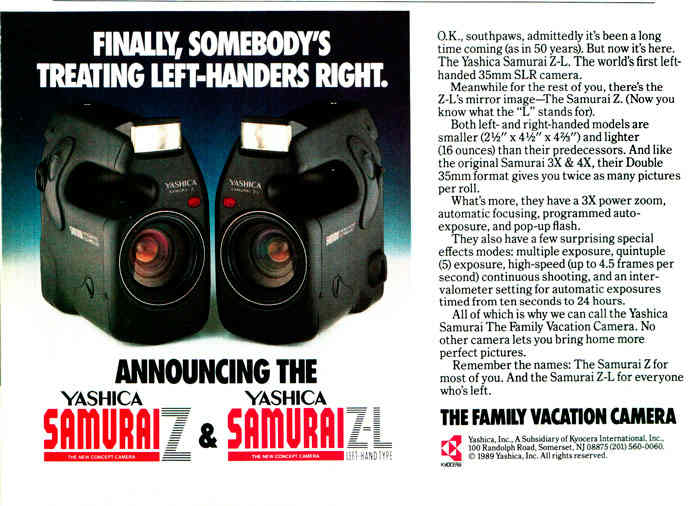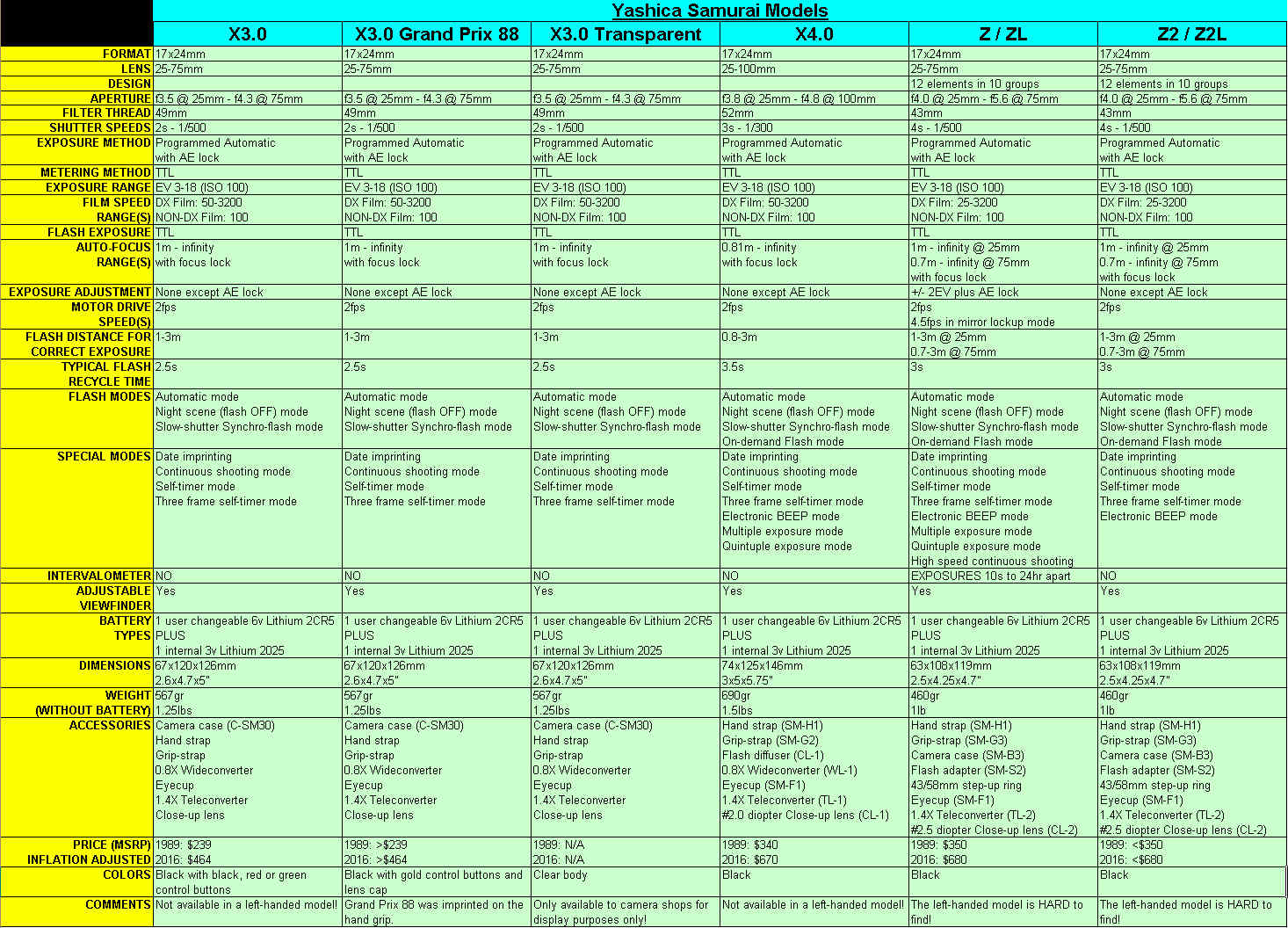

The Samurai series was not the first half-frame SLR, but it was certainly the most advanced half-frame ever made. Depending on how you look at it there were anywhere from four to eight models made. The table at the bottom summarizes the models' main features. Keep in mind that some of the cameras only show the "YASHICA" name, some only the "KYOCERA" name, and many have BOTH -- often in different places on the camera -- even though they are USUALLY the exact same camera. Even though the cameras are usually exactly the same, they are listed here according to the brand name on the front of the camera.
(1988) The Samurai X3.0 was the first model of a series of ergonomic (built-to-fit-the-hand for one-hand operation), half-frame, "bridge" SLRs that Yashica manufactured beginning in 1988. It is a true SLR camera which makes it stand out from many point-and-shoot cameras, as does its half-frame format. The zoom covers a useful range -- 25-75mm in half-frame, which gives an image size approximately the same as a 35-105mm zoom in full-frame. The lens is threaded for a standard 49mm filter, and gives effective f-stops from f3.5 at wide angle to f4.3 at telephoto. The viewfinder has an adjustable diopter to fit sharpness to the user's vision. Shutter speeds range from 2 sec. to 1/500 sec. The shutter speeds and aperture are automatically set by the camera, and there are no manual settings. But there is a built-in flash which can be turned off, turned on, or left to operate in various automatic modes. The exposure, film advance and focusing are strictly automatic and the zoom is motorized. The standard model is all black, but two "color" models were made with the various control buttons in either red or green, as well as a colored ring around the lens. Various accessories were available, such as wide and tele lens converters, cases, straps, etc. It uses one long-lasting and easy to change 2CR5 battery for the main operations, but it has a more difficult to change internal battery a CR2025). Accessories include: camera case (C-SM30), shoulder strap, hand/grip-strap, 0.8X wide-angle converter, eyecup, 1.4X tele-converter, close-up lens, and add-on flash hot shoe.
(1988) When the Samurai X3.0 won the "Camera of the Year" award, Yashica decided to produce a commemorative version -- of sorts. It's the same thing as the original but it has a gold shutter release, a gold lens cap and the words "GRAND PRIX 88" in gold on the hand grip. Hard to find.
(1988) It's the same thing as the original but it has a transparent body -- so stores could show customers how it works. These were not for sale, just for display purposes.
The X4.0 is a modified version of the X3.0. The main difference is the lens -- it's now a 25-100mm (f3.8/4.8) zoom -- which requires a slightly enlarged camera and lens body, but the overall shape and use was not changed. The lens change also requied a move to a larger filter thread -- 52mm. On this model you don't need a ''clip on'' hot shoe adapter like you do with the other versions to add additional flash. It's built in so regular, hot shoe, flash units can be used. A special flash was made for the camera, the CS-140. It was more powerful than the built in flash and turns off the built-in flash when attached. In addition, the shutter speeds have changed a little, here they are 3-1/300 sec. instead of 2-1/500 sec. Also multiple exposure automatic mode was added allowing up to 5 shots with one press of the shutter release. The battery construction was basically the same, but the internal battery is now soldered in place. Accessories include: shoulder strap (SM-H1), hand/grip-strap (SM-G2), flash diffuser (CL-1), 0.8X wide-angle converter (WL-1), eyecup (SM-F1), 1.4X tele-converter (TL-1), #2.0 diopter close-up lens (CL-1), dedicated accessory flash (CS-140). Yashica dropped the coloring on this model.
The only word for this camera is "WOW". It's a smaller version of the original Yashica Samurai, but it did not skimp on features -- just size. In fact, it adds some features! And unlike a lot of auto-everything cameras there are no buttons or switches to set before use. Simply drop in the film cassette, push the ON lever and you are ready to shoot. The zoom toggle falls under your index finger naturally. A slight press on the shutter release (right next to the zoom toggle) focuses the lens and determines the exposure. A final press takes the picture. It has a 25-75mm motorized zoom (equivalent to a 35-105mm on a full frame 35mm camera) (f4.0/5.6) lens with 12 elements in 10 groups. It has a through-the-lens, center-weighted silicon exposure system that automatically controls the electronic shutter (from 4 seconds to 1/500) and the aperture. Automatic DX coding of film from ISO 25 through 3200. Manual exposure compensation of +/- 2 f-stops. Autofocusing from infinity to 28 inches. Motorized film advance and rewind can be set for single or continuous film advance up to 4.5 frames per second. Multiple exposure, self-timer, intervalometer and combinations of these are built-in for fascinating picture possibilities. Features and settings are displayed on an LCD panel on the back of the camera. Built-in calendar and clock can imprint film with various date and time configurations. LED's in the viewfinder tell you if the focus and exposure are correct. You can also turn on -- or off -- a beeper as an auditory check. Built-in pop-up flash can be set for automatic, manual, fill-in and other settings. Includes tripod socket and even diopter adjustment on the viewfinder. Accessories include hand strap, side-grip strap, case, additional flash adapter, 43-58mm step-up ring, eyecup, 1.4x screw-in teleconverter (yielding a 50-150mm zoom), and closeup lens (focusing to 14 inches). Put all this stuff in a regular 35mm SLR, and you'd need a suitcase! But yet, it all fits in one hand! And the list of features goes on! You can see why this camera has been selected as the "mascot" for this web site. Although the manual features of this camera are limited, the sharpness of the lens alone makes up for it. The battery construction was technically the same, but the internal battery (a 2025) is much harder to get at -- at least it is not soldered in place! Accessories include: shoulder strap (SM-H1), hand/grip-strap (SM-G3), camera case (SM-B3), flash adapter (SM-S2), 43/58mm step-up ring, eyecup (SM-F1), 1.4X tele-converter (TL-2), #2.5 diopter close-up lens (CL-2). Like the X4.0, it was only available in all black.
Left-handed version of Samurai Z. The battery construction was basically the same. Hard to find.
This was the first Samurai with the Kyocera name on the front plate -- instead of "Yashica".
The two names were simply swapped from the front to the side -- but that's not the only change. For some reason,
the accessory flash connections on the top of the original Yashica X3.0 were dropped on the Kyocera X3.0. The difference
is easy to miss, but the orignal Yashica Samurai X3.0 has a plate on the top with connections for the SM-S1 accessory.
Yashica called this the Portrait Flash Adapter, but it's just a screw-on, standard hot shoe for an extra flash
-- which the Samurai X3.0 lacks. Yashica made a special compact flash for the Samurai X3.0, the CS-140, which helps
reduce "red eye", but any hot shoe flash can be used. This top plate is removed from the Kyocera Samurai
X3.0 -- compare photos -- so accessory flashes cannot be attached.
Probably exactly the same as the earlier Yashica model, with the Kyocera label on the front. The Samurai X4.0 has a built in hot shoe, and it is retained on the Kyocera model.
Probably exactly the same as the earlier Yashica model, with the Kyocera label on the front.
Probably exactly the same as the earlier Yashica model, with the Kyocera label on the front.
A later (1990) version of Samurai Z with a few features dropped (see table below) -- as well as the Yashica name on the front of the camera. The battery construction was basically the same, and Yashica brought back some coloring to the cameras.
A left-handed version of Samurai Z2. The battery construction was basically the same. Very hard to find.

To return to the main index for the Sub Club click here.
COPYRIGHT @ 1995-2019 by Joe McGloin. All Rights Reserved.